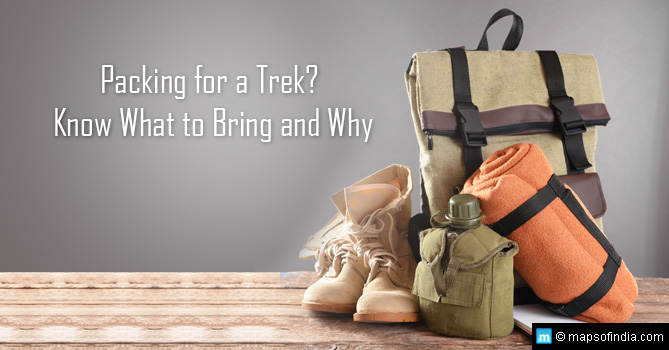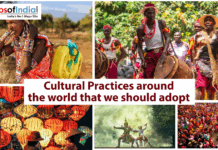India is a paradise for outdoor lovers with plenty of options for all types of treks. The best season for treks in the country is just about starting now, immediately after the monsoons and right until early- to mid-November before the cold begins to set in.
If you are new to trekking or if you are an on-off trekker, you will find information here both useful and comprehensive to get you started right away. So read through and get set to pack up your backpacks.
Preparing for a trek
It is advisable for first-time trekkers, and for that matter, all trekkers, to begin a fitness routine well before the trip, which involves a combination of jogging, brisk walking, sit-ups and preferably a cardio routine. This will help tone up the muscles and improve oxygen intake capacity that will be necessary on your trek. If you can walk with a loaded backpack, that will be great.
Backpack
You need a well-designed, sturdy backpack that is waterproof or at least water-resistant. The design must maximize content carrying based on the maximum weight that you are comfortable carrying. First-timers are advised to carry a minimum load but retain all essentials as listed below.
Good outdoor and camping gear in India can be bought from:
- One-stop shop: Decathlon – a popular international brand offering comprehensive one-roof solutions for all trekking and camping gear. It has stores in most major cities in India.
- Trekking shoes: Woodland, Timberland. There are a lot of options in the market. (Choose ankle-length shoes that have a decent grip on the sole. The shoes must fit you well.)
- Backpacks: Wildcraft, Victorinox, American Tourister, Fastrack, Puma, The North Face and VIP.
- Swiss Army Knife: Victorinox.
- Multifunction all-weather Watch: Casio.
Comprehensive Checklist:
Sleeping bag (1), tents & pegs (if needed), light roll mattress (1), trekking pant (2), warm inner wear – top & bottom (2), sweat shirt full (2) and t-shirts (3), underwear (4 sets), Handkerchief (4), rain/ wind/ snow protection outerwear with hood (1), water-resistant trekking shoes (1 pair), cotton socks (3 pairs), protection gloves (1 pair), special water bottle (1), medical kit bag (1), sunglasses (1), trekking hat (1), woolen head cap (1), waist pouch for mobile phone, money etc (1), compass (1) and altitude watch cum tracking device (1), portable cooking (1) with chemical burning disks (15-20 disks) and lighting equipment (1 set), LED torch (1), rechargeable batteries (as per device), rope and winch (1), multiple point internationally compatible charger (1), joint and muscular support aids for elbow and knee (1 set), head-mounted light (1), walking stick (1), Swiss Army knife (1), mobile phone power bank 10000 mAh (1), toilette paper, disposable shaving razor (4), shaving cream (1), tooth paste (1), tooth brush (1), tongue cleaner (1), tooth pick (1 pack), tissue paper (small pack), liquid hand sanitizer (1), cup (1), spoon (2), liquid soap or soap bar, hair brush or comb (1), moisturizer (1), lip cream (1), mouth freshener (1 Listerine small), gas lighter (2), pocket notebook and pen (1 each), a road map (hard copy) of the region that you wish to trek in (1) just in case your mobile is out of coverage area, carry a strong but disposable litter bag to bring back your litter (3).
In addition, you will need to carry the following medication and other essentials:
- Amoxicillin strip (antibiotic – 2 strips), Norflox strip (antibiotic for stomach upset – 2 strips), Paracetamol strip (fever – 2 strips), thermometer (1), Electoral sachets (rehydration – 1 packet), Glucose Powder (rehydration – 2 packets), Volini (muscle relief Spray – 1) and Voveran SR 100 tablets (muscle pain relief – 1 strip), Band-Aid strips, Anti-biotic lotion like Dettol/Savlon (1 bottle), Sterilized Gauze and tape, 3M Micropore tape (1 roll), crepe bandage (1 roll), water sterilizing tablets or drops.
- Sunscreen lotion
- Anti-Mosquito repellent cream or lotion – Odomos.
- High protein biscuits and bars – Protinex, Threptin, RiteBite
- Chocolate bars – Snickers, Dry fruit bars (Granola), Peanut Butter Jar, Cheese spread Jar, canned food (as per choice and keeping overall weight limitation in mind), Maggi or Knorr Noodles.
- Reading book – as per choice. Trekking is a great time to catch up on some quality reading, so carry a book by your preferred author along. The latest edition of ‘Lonely Planet’ will help.
- In case you prefer to write, a bigger notebook may be a great idea. If you are into nature photography, you might want to take along a DSLR camera if you feel your mobile phone camera is not good enough. Choose between a Canon EOS series, Nikon or Sony DSLR camera with accessories, as per preference.
Remember, you have to prepare your own packing list based on the maximum weight that you can carry and endure through the trek, and also on whether you are going alone or with others. In this case, you can divide the essentials between yourselves and carry additional food and clothing load per person.
Some tips for a smarter trek
- Get to know the region and terrain that you plan to trek in and familiarize yourself with known landmarks along the route that you plan to travel in.
- Read up on local people and culture, food, festivals and a few greetings and questions in the local language will always help you endear and connect with the locals.
- Always travel light, but include all essentials.
- Carry some extra chocolates or candies to share with local children, they love it.
- Your phone must have the local hospital, police station, and District Magistrate office numbers. Also note down the addresses and numbers of the nearest post office and bank, you never know when you might need it.
- Never break local rules or customs, and don’t litter (bring back your litter to dispose of in a designated place in the village/town).
- Be polite, keep your voice low and respect the local people, don’t play loud music and most of all avoid drinking and making a nuisance of yourself. Urban arrogance is disliked by all.
- Plan well to reach your trek starting point and proceed with a local guide.
- Ensure all outerwear is waterproof, wind resistant and offers adequate thermal insulation.
- While on trek, don’t push yourself to keep up with others, listen to your body and speak to your guide if you are excessively tired or feeling unwell.
Where to go for a trek
In the North, Ladakh, Himachal Pradesh and Uttarakhand offer a variety of trekking options from low-altitude to middle and high-altitude treks, depending on the experience and fitness of the trekker.
Newcomers are well advised to restrict their treks within 14,000 feet altitude, and not exceed 4-5 KMs per day initially, even if your body feels it can take more. This can progressively increase to 6-7 KMs if you are on a long trek, and your body acclimatizes easily to the increased stress.
Stress levels for covering 1 km in the hills are the same as brisk walking 3 km in the plains; don’t forget that you are carrying an additional load that you don’t carry in your usual walks. This is why a high cardio fitness routine is well recommended before embarking on a trek, especially at higher altitudes.
Treks in higher ranges have season limitations for trekking, but there are several round-the-year places, mostly in low-altitude or jungle terrain, that one can choose from.
Some popular treks are mentioned below.
North India:
Trekking in Ladakh:
- Markha Valley Trek – altitude 5000 ft. The best time is June to September.
- Lamayuru to Darcha Trek – altitude 16,400 feet. The best time is July to September.
- Ripchar Valley Trek – altitude 14,000 feet. The best time is July to September
- Markha Valley to Stok Kangri – altitude 16000 feet. The best time is June to mid-October.
Trekking in Himachal Pradesh:
- Hampta Pass Trek – between Kullu-Manali valley to Chandra valley in Lahaul – altitude 13800 feet. The best time is June to October.
- Baralacha Chandertal Trek – a trek from Baralacha to the lovely Chandertal or the Moon Lake – an altitude of 16000 feet. The best time is April to October.
- Triund Dharamkot Trek – trekking through the foothills of the Dauladhar range, the meandering trek takes you through Dharamkot – 9800 feet. The best time is August to October.
- Mcleodganj Chamba Trek – the trek through forests continues with Pir Panjal mountains and the Dauladhar ranges in the backdrop – altitude 12000 feet. The best time is April to June and September to October.
For further information on state trekking, you may like to contact:
- Himachal Pradesh: Atal Bihari Vajpayee Institute of Mountaineering and Allied Sports in Manali (ABVIMAS).
Trekking in Uttarakhand:
- Chopta Chandrashila Trek – located on the Gopeshwar-Ukhimath route, Chopta to Chandrashila will take you to the famous Tungnath temple which is the highest among all temples in the Himalayas. Chopta lies at an altitude of 9500 feet. The best time is March- November.
- Rishikesh Valley of Flowers Trek – starting at Rishikesh this is an easy 3 km trek to Valley of Flowers and one can return on the same day. Altitude – 11800 feet. Open through the year; however, avoid the monsoons.
- Kuari Pass Roopkund Trek – the trek will offer you breathtaking views of Nanda Devi, Chaukhamba, Trishul and Kamet. Kuari is at an altitude of 13600 feet and Roopkund is at 14800 feet. The best time is June, September and October.
For further information on state trekking, you may like to contact:
- Nehru Institute of Mountaineering in Dehradun.
East India:
Trekking in Arunachal Pradesh
- Dibrugarh Siang Valley Trek – the beautiful trek starts from Dibrugarh before passing and takes you through Yembung, Sessen, Ponging, Marying, Milang and Peaka Modi and finally ends at Siang Valley.
Trekking in Sikkim
- Dzongri Trek – start your trek at Yuksam before passing through forest areas of Bakkhim and Phedang, before finally reaching Dzongri at an altitude of 13100 feet.
- Yuksom Goecha La Trek – you start the trek at Yuksom at an altitude of 5600 feet and trek through the beautiful terrain of Sachen, Tshoka, Dzongri and Thansing before encountering the ice-capped surroundings of Goecha La. The best time is September to November and March to April.
Trekking in North Bengal
- Maneybhanj Sandakphu Trek – starting at Maneybhanj you can reach Sandakphu through Tonglu or follow the Tonglu – Phalut route. The best time is March to May or October to December.
For further information on state trekking, you may like to contact:
- West Bengal: Himalayan Mountaineering Institute in Darjeeling.
West India:
Trekking in Maharashtra:
- Ratangad Hill Fort Trek – the trek starts at Pen and takes you through Sapoli, Deevanmal and Kamarli before reaching Ratangad Hill Fort. The best time is October to February.
- Kundeshwar Bhimashankar Trek – the trek starts at Kundeshwar and passes through Kusur and Talpewadi before touching Bhimashankar. The best time is October to February.
- Khandpe Rajmachi Hill Fort Trek – the trek is best experienced in September when the valley is still green in the post-monsoon period. Rajmachi Hill Fort is at an altitude of 2700 feet. The best time is September to February.
South India:
Trekking in Karnataka:
- Kumara Parvata Trek Coorg – this 2-day trek takes you through Sesha Parvata before reaching Kumara Parvata. The best time is November to February.
- Mullayanagiri – BabaBudangiri Trek – Chikmagalur – the trek takes you to twin peaks Mullayanagiri (6,330 feet) and BabaBudangiri. The best time is November to March.
Trekking in Tamil Nadu
- Perumedu Waterfall Trek in Yelagiri – located at a height of 3400 feet and 220 km from Chennai, Yelagiri is a picturesque hill station from where you start your trek to Perumedu Waterfalls. The best time is November to February.
- Yercaud Hill Range Trek – located 367 km from Chennai, at an altitude of 5000 feet and part of the Shevaroy range, Yercaud offers several trekking trail options that are suitable for light trekking. The best time is October to February.
Trekking in Kerala
- Chembra Peak Trek in Wayanad district, Kerala – after trekking a steep gradient the trek eases into a beautiful trek leading to Chembra Peak – altitude 6900 feet. The best time is October to February.
So go ahead, grab your backpack and hit the trail. A beautiful country awaits you!
Read More: Top Monsoon Treks in India | Trekking in India





